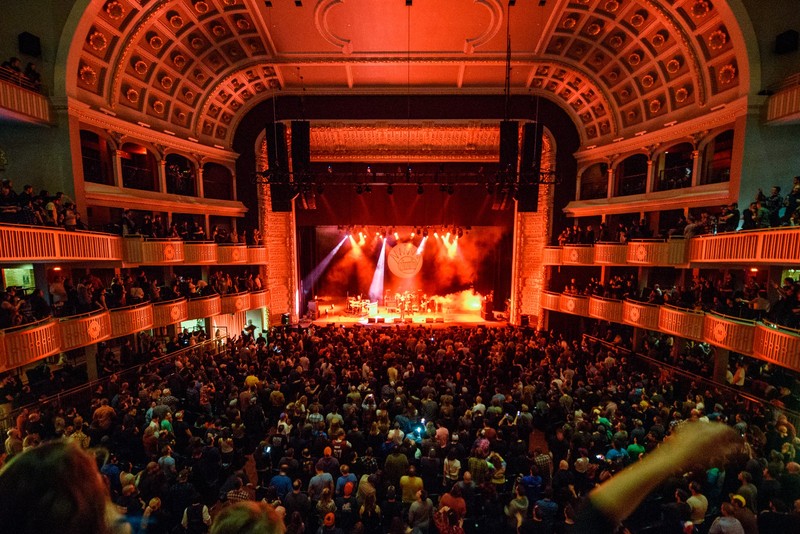The Met Philadelphia
Introduction
Text-to-speech Audio
When it was built in 1908, The Met Philadelphia, which was originally called Philadelphia Opera House, became the city's second opera house. At the time, New York City, Paris, and now Philadelphia were the only cities in the world to boast having two opera houses. The Met, as it's commonly called, was built by impresario Oscar Hammerstein I and was the work of Brooklyn-based architect William H. McElfatrick, who specialized in designing theaters. In addition to being a performance venue, The Met has been used for a variety of purposes including as a sports arena, dance palace, union hall, movie theater, and for cooking demonstrations. It was added to the National Register of Historic Places in 1972.
Images
The Met Philadelphia was built in 1908 by Oscar Hammerstein I (the grandfather to American playwright Oscar Hammerstein II).

Backstory and Context
Text-to-speech Audio
The Met was the ninth opera house Hammerstein built. Hammerstein, who was the grandfather of famed American playwright and lyricist Oscar Hammerstein II, was born in Germany in 1846. He became interested in music at an early age and learned how to play the piano, flute, and violin. He studied music at the Music Conservatory of Berlin and hoped to become a ballet and opera composer. When he was 20 years old, he immigrated to America and arrived in New York City where he got a job at a cigar factory and rose to a management position. Eventually, he owned a highly profitable factory that made cigar manufacturing devices.
Hammerstein then invested real estate for a short time before returning to music. In 1889, he built his first theater, the Harlem Opera House, which was later demolished. He continued to build other theaters in the coming years and in 1906 established the Manhattan Opera Company, which became a successful competitor to the Metropolitan Opera Company of New York. In early 1908, Hammerstein was invited to put on a show at the Academy of Music in Philadelphia. It was well received and convinced him to build the Philadelphia Opera House. It was built quickly and opened on November 13 (he had already bought the property months earlier).
The theater had a capacity of 4,000 patrons and was noted for its excellent acoustics and design. The exterior is composed of white brick, terra cotta, and marble and a Neoclassical facade featuring a pedimented center pavilion, arched windows, and decorative stone modillions. There were also originally two domes at either end of the building. Inside, the theater had 28 seating boxes, a large orchestra pit that could accommodate 120 musicians, a promenade under the balcony, and a large lobby. It was highly decorative as well with columns covered in gold leaf, cherubs and lyres, and ceilings featuring chandeliers and classical motifs.
Despite Hammerstein's best efforts, the opera house struggled financially. Locals wondered why he built it so far from the city's center and doubted enough regular subscribers would support it. In fact, at the curtain call of the first performance, which was a production of the opera, Carmen, Hammerstein came on stage and asked for support. During the first season, only his opera company put on shows; the theater was closed the rest of the time. In 1910, Hammerstein was forced to sell the theater and all costumes, sets, and the deed to the Metropolitan Opera Company (MOC) and agree to not put on shows in Boston, New York City, Chicago, and even Philadelphia for ten years. He then moved to Paris and remained for some time before returning to America. He died of kidney failure in New York City in 1919.
The MOC renamed the theater the Metropolitan Opera House and operated it until 1920. Various opera companies used the theater until 1934 and movies began to be shown as well. Five years later, the building became an athletic venue (the auditorium was converted into a basketball court). Unfortunately, a fire in 1948 destroyed much of the interior and the building was converted into an auto mechanic school. Then in 1954 it became an evangelical church. After the church closed the building fell into disrepair and the city condemned it in 2000. A local church then raised enough money to prevent its demolition and begin restoration. However, the work was delayed for many years until around 2017. The Met reopened on December 3, 2018.
Sources
"History." The Met Philadelphia. Accessed January 3, 2022. https://themetphilly.com/history.
Maule, Bradley. "The Met's Next Revival." Hidden City. October 3, 2013. https://hiddencityphila.org/2013/10/the-mets-next-revival.
McClung, Rob. "The Rise, Fall, & Revival of North Broad's Opera Palace." Hidden City. June 14, 2018. https://hiddencityphila.org/2018/06/the-rise-fall-revival-of-north-broads-opera-palace.
Tinkcom, Dr. Margaret. "The Met of Philadelphia Evangelistic Center." February 1, 1972. National Park Service - National Register of Historic Places Nomination Form. https://s3.amazonaws.com/NARAprodstorage/lz/electronic-records/rg-079/NPS_PA/72001163.pdf.
The Met Philadelphia
